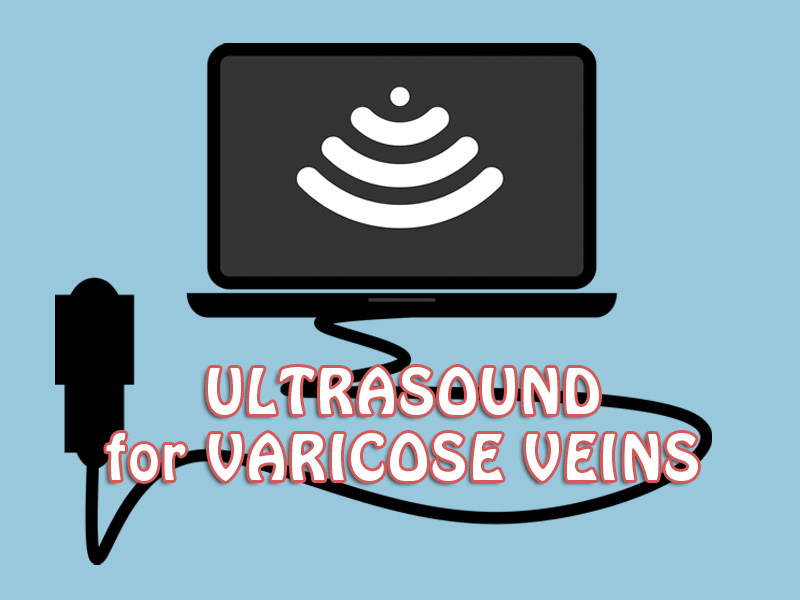
Ultrasound for varicose veins? When you hear the word “ultrasound,” the first image that pops into your mind is probably of a pregnant woman getting her first glimpse of her unborn baby! But did you know that ultrasounds are also used to diagnose varicose veins?
Many of the tests that used to be used for the diagnosis of varicose veins are now considered obsolete. Using ultrasounds to map out varicose veins prior to treatment has become the gold standard in varicose vein treatment. In addition, all insurances require an ultrasound in order to approve treatment.
If you want to read up on veins and venous disease, you’ll find our complete run-down here.
But in this article, we’re going to tell you why you should work with a provider who diagnoses varicose veins by using an ultrasound scan. We’ll also take you on a quick trip through the process. And on the way, we’ll be answering questions such as
- Can ultrasound help varicose veins?
- How is ultrasound for varicose veins done?
- How long does it take?
- What to expect during ultrasound for varicose veins
Why Ultrasound is the Best Option for Vein Mapping
Although we typically associate varicose veins with the large swollen red, purple, or blue veins that bulge up under the skin, not all varicose veins are evident to the naked eye. Some varicose veins lie far beneath the skin, even buried deep in the muscles, and require modern technology to find.
Although ultrasounds don’t directly help varicose veins, they help doctors accurately determine where the vein problems are located. A venous ultrasound scan can also
- determine the cause of long-term leg swelling
- identify which valves are damaged
- pinpoint abnormal blood flow
- search for blood clots
Ultrasound for Varicose Veins: a Quick Guide to How it Works
We use venous duplex ultrasound scanning, so that’s what we’ll focus on here.
Duplex ultrasound scanning works in three stages.
Stage 1: The initial process is a “greyscale/B-mode ultrasound” scan, which is the standard ultrasound scan used on pregnant women. Doctors apply gel to the area and roll a scanner to see what’s going on within the body. Ultrasound scanners do not produce radiation or require needles or injections.
Stage 2: The next part of the process is a “Doppler ultrasound” scan that’s beamed into a specific area of the body and can be inserted into the vein. Doppler ultrasound is used to measure blood flow in the vein.
Stage 3: The final part of the scanning process is the “color-flow”/”color-coded” element. Movement on the black-and-white ultrasound picture can be “coded” by a computer as either red or blue depending on flow direction. This enables vein specialists to see blood flow in a vein in real time. They can also see whether the blood flows up and the vein is healthy or if it flows down because the valves are not working.
How a Vein Specialist Uses the Information Gained From a Venous Ultrasound
Your vein specialist uses an ultrasound examination both to identify the damaged veins that have faulty valves and to map the anatomy of the veins. This creates a “road map”. The map will give them the information they need to accurately assess the cause and extent of the varicose veins and formulate the best vein treatment plan.
What to Expect During an Ultrasound Vein Scan
Prior to your appointment
There’s no preparation for an ultrasound scan. Simply drink plenty of fluids so you’re hydrated and ditch the compression stockings on the day of the examination.
During the appointment
You’ll need to stand for the part of the exam that checks for leaky valves. There will be no probing, incisions, or injections.
The specialist will apply a warm gel to your legs and then gently glide the ultrasound device over your skin. You can see what’s going on in your legs on the monitor if you’d like!
How long will it take? Most Ultrasound appointments take less than 30 minutes to complete.
After the appointment
You don’t need to do anything after the exam. And there’s no recovery required after a duplex ultrasound session. Your vein specialist will take a look at the vein map, and other information gathered during the ultrasound scan, and create a customized vein treatment plan just for you!
There are no risks or side effects associated with a duplex ultrasound for varicose veins.
Ultrasound Vein Mapping and Diagnosis: Who Should Perform One?
Although anyone can legally perform a venous duplex ultrasound scan, you don’t want just anyone making your diagnosis.
Getting a correct diagnosis and treatment plan depends on three things:
- Technical training
- Experience using the equipment for diagnosing varicose veins
- The quality of the duplex ultrasound scan machine
Unfortunately, not all doctors or other practitioners receive in-depth training in using duplex scanners, so it’s crucial you find a vein specialist who has a thorough understanding of ultrasound physics, knows how to get the best out of their machine, and is clear about exactly what they should be scanning.
How Does That Sound?
Can ultrasound help your varicose veins? The answer is yes. When it comes to varicose vein treatment, we don’t mess around. And neither should you.
At Denver Vein Center, we have everything you need to get the results you’re looking for under one roof. The first step is to schedule an appointment for an ultrasound with Dr. Norton.
At your appointment, Dr. Norton will
- ultrasound your legs,
- take down your medical history, and
- listen to your concerns.
Then she’ll diagnose the problem and set you up with a treatment plan. Don’t worry, she’ll also take the time to explain the recommended procedures.
In addition, a member of our staff can explain what your insurance may cover and whether or not you need pre-authorization. Then we’ll get you set up with your first vein treatment appointment so you can step outside with confidence again!